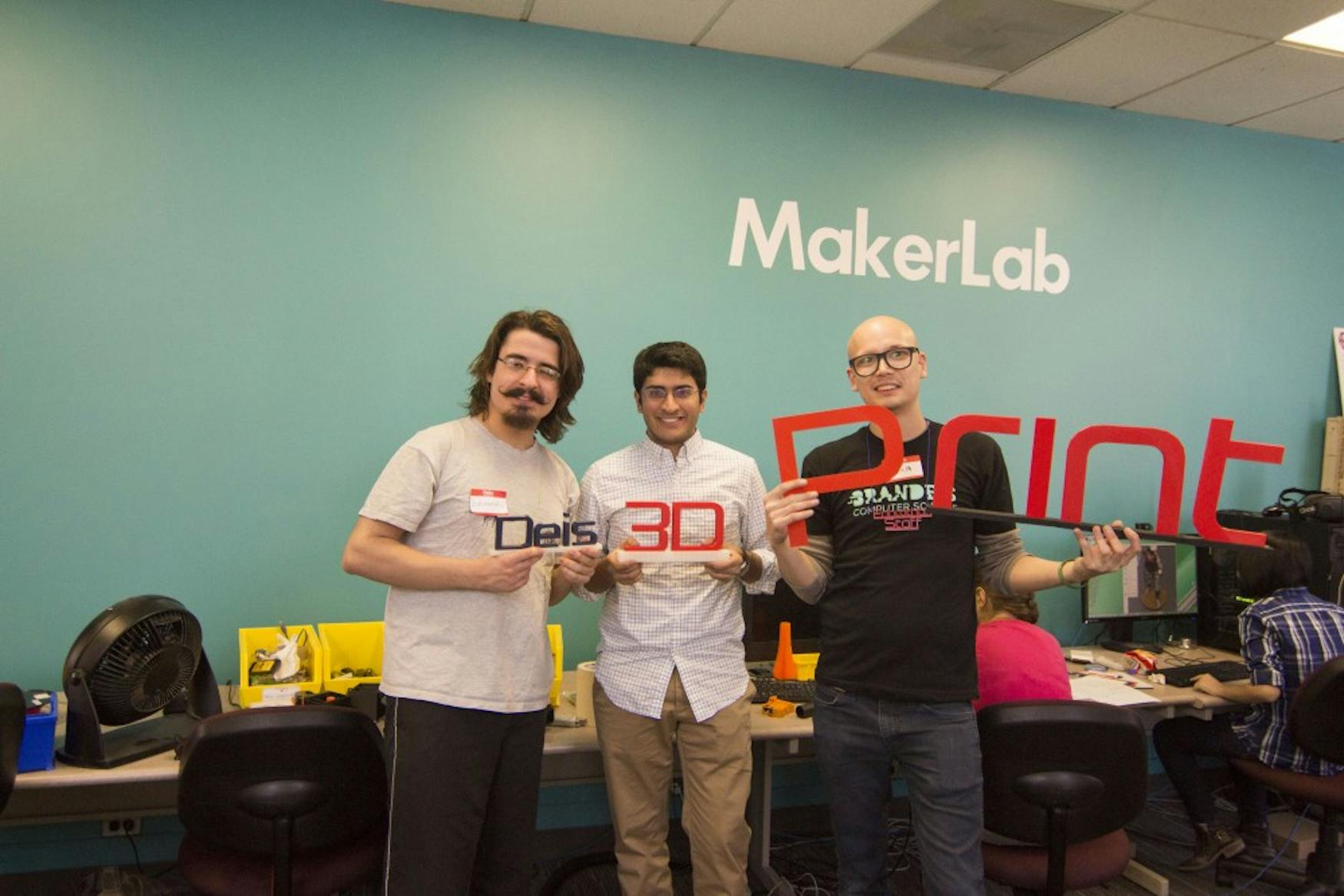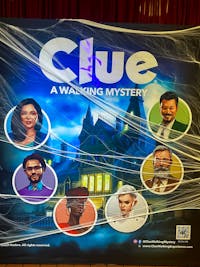Printing with Purpose
Brandeis hosts the University’s first 24-hour 3D Printathon in conjunction with the Deis3D club and the MakerLab
At the top of the Farber Library stairs, a high-top table is lined with boxes of free Monster energy drinks and coffee dispensers. On nearby tables, 3D printers hum and whir melodically, the sound of new-age creation. Teams of three to six students huddle in separate alcoves, around computers and white boards, brainstorming big ideas and fine-tuning the mechanics necessary to print them into reality.
Students from across the Northeast have gathered here for a Printathon this weekend to mark the first 24-hour 3D printing competition at Brandeis. When the six teams arrived—two from Brandeis, one from Waltham High School, two from the University of Connecticut and one from Columbia University—judges revealed the competition’s theme meant to inspire their designs, which were scheduled to be judged only 24 hours later. The theme was social justice.
Noah Fram-Schwartz co-founded the 3D printing club at Brandeis, called Deis3D, last February. He now works as the 3D Design Lab Lead at Google and flew in from California to serve as a judge at the competition. Fram-Schwartz created the club “partly because I really wanted to share this passion with people and partly because … there’s no Engineering program here; Brandeis doesn’t really have as many people who are super into the tech industry as I think it should ... once you combine that with people who are super into social justice, then you can just do anything,” he says, rolling his chair back and forth in excitement.
“[The Printathon] was in good part Noah’s idea,” Eduardo Beltrame ’15, an exchange student from Brazil and the current president of Deis3D, says.
Between its creation and the Printathon, Deis3D has collaborated with a range of clubs and projects on Brandeis’ campus, proving that you really can use 3D printers for anything, from attempting to print swirled frosting on top of cupcakes with the Brandeis Cupcake Obsession Club to printing chess pieces with the Brandeis Chess Club members’ names engraved in them. Beltrame likes to print protein molecule models and bring them to biochemistry classes. “It immediately conveys to anybody a sense of ‘woah this is cool,’ instead of dry and abstract description,” Beltrame says.
Deis3D member Gabriel Seltzer ’18 worked closely with the team from Waltham High School to show them how to design and print their idea for the competition. “We’re working on water wheels and seeing if we can generate electricity with that,” Seltzer said.
None of the teams or Deis3D members had participated in a Printathon before this event. The idea came from a traditional hackathon, in which a large number of people come together to participate in collaborative computer programming. “Traditionally, hackathons are [about] how much can you get done in 24 hours—the fun value of staying up all night. You really have to be working the whole time to get something impressive done, so people have to stay focused,” Seltzer said.
One of the two Brandeis teams, “Louis Makers” made a balancing scale that represents gender equality through conjoined gender signs. Modeled hands held up the gender signs that doubled as bracelets. Danny Kimmel ’17, a member of the “Louis Makers” and Deis3D club, likes to print Tyrannosaurus rex skulls and has even made his very own watchband.
“I joined in November, and I kind of just picked everything up,” Kimmel said. “I don’t think it’s hard, I just think a lot of people are intimated by it, so it’s really hard to recruit people because nobody wants to give it a try because they think it’s going to be really hard to learn, but it’s not.”
Deis3D played an important role in the creation of the MakerLab—the innovation lab at Brandeis. Research Technology Project Lead of the MakerLab Ian Roy ’05 is also the faculty adviser to Deis 3D.
Through his influence, Deis3D and the MakerLab have created a companionship. Once Deis3D was approved as a club at Brandeis, Library and Technology services supported it, and soon the MakerLab opened in June 2014. “It has totally changed our tech culture in nine months,” Roy explained.
In addition to 3D printing, the MakerLab works with virtual reality and embedded systems and has even pieced together its own drone. In the past, the MakerLab worked with the Anthropology department to produce model skulls for students to have.
Instead of passing around a few models, the MakerLab has scanned them and produced enough for each student to have their own.
The MakerLab has also collaborated with Deis3D and started printing prosthetic limbs for children whose families can’t afford to buy a new, expensive model every time the children’s changing bodies outgrow the last ones. The 3D-printed prosthetics are part of a global organization called e-NABLE.
In fact, the MakerLab offers free 3D printing training to anyone who wants to learn. It takes about an hour and consists of learning about the printers and printer safety, and then leads into printing something by yourself.
The Service Coordinator at the MakerLab, Hazal Uzunkaya ’14, emphasized how easy printing is, because material can be recycled and re-used.
“There’s no such idea as messing up something, because it’s a learning experience,” she explained. The MakerLab does maintain rules that forbid printing guns, sex-related objects or drug paraphernalia.
At the Printathon, the first place award went to The University of Connecticut’s 3D Printing club for their creation of a design that allowed a prosthetic leg to attach to a bicycle pedal. They won their design 3D printed in real materials and a $250 gift card from Shapeways. Shapeways is a 3D printing service that can commercially print with any materials like wood, metal or even gold. The first-place team also won a Netfabb software license valued at over $750. Netfabb is an advanced software company for 3D printing. Shapeways and Netfabb both sponsored the Printathon with printing supplies and prizes.
The runner-up team was Waltham High School, which under the leadership of Seltzer, created a way to turn any discarded motor into a water wheel that generates electricity. They won five spools of DeltaMaker filament, the plastic used to print with 3D printers, valued at $200.
Columbia University’s team came in second place with their design for a Braille phone case that allowed for Bluetooth text input.
They didn’t have enough time to assemble it into a phone case, and team leader Jason Powell commented that they could have completed a prototype if they had had more time. They plan to release the designs publicly on a website for those who can benefit from it. “I was blown away by the positive communal atmosphere of contribution and the spirit of inspiration we were able to convey,” Roy told the Justice in an email. “I was impressed.”
Brandeis’ very first Printathon, and the first known northeastern university Printathon, led to several real-world applications to social problems from students across the Northeast. With the help of several sponsors, Deis3D and the MakerLab were able to demonstrate 3D printing innovation in a way that is vastly advancing the modern world and the campus community.
It seems that Fram-Schwartz’s idea for a Printathon holds true: “Given the proper environment, if you want to change the world, you will … If you are part of Deis3D, you have the right environment. You can change the world, you just have to try.”




Please note All comments are eligible for publication in The Justice.